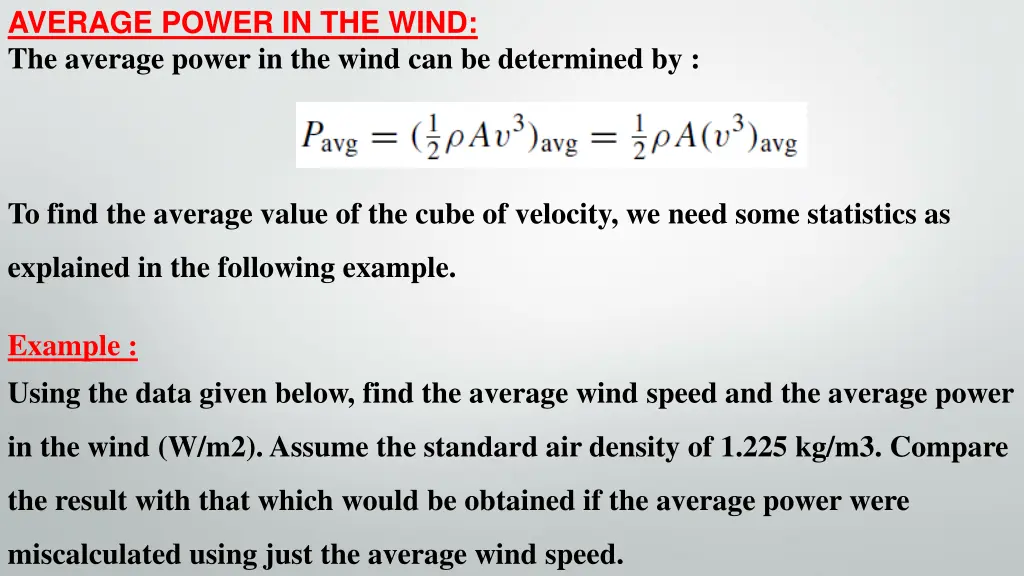
Average Power in Wind Analysis: Calculating Wind Speed and Power
Learn how to determine the average power in wind by analyzing wind speed data. Compare calculations with and without considering the cube of velocity. Discover the impact of statistics on wind power calculations.
Download Presentation

Please find below an Image/Link to download the presentation.
The content on the website is provided AS IS for your information and personal use only. It may not be sold, licensed, or shared on other websites without obtaining consent from the author. If you encounter any issues during the download, it is possible that the publisher has removed the file from their server.
You are allowed to download the files provided on this website for personal or commercial use, subject to the condition that they are used lawfully. All files are the property of their respective owners.
The content on the website is provided AS IS for your information and personal use only. It may not be sold, licensed, or shared on other websites without obtaining consent from the author.
E N D
Presentation Transcript
AVERAGE POWER IN THE WIND: The average power in the wind can be determined by : To find the average value of the cube of velocity, we need some statistics as explained in the following example. Example : Using the data given below, find the average wind speed and the average power in the wind (W/m2). Assume the standard air density of 1.225 kg/m3. Compare the result with that which would be obtained if the average power were miscalculated using just the average wind speed.
Site data and the resulting wind histogram showing hours that the wind blows at each wind speed.
Wind speed Mile/hour V 13 14 15 16 17 18 19 20 21 22 23 24 25 ======= ======= Sum Wind speed Mile/hour V Hours/ year h Hours/ year h ?? V x h ?? x h ?? V x h ?? x h 243 170 114 74 46 28 16 9 5 3 1 1 0 3159 2380 1710 1184 782 504 304 180 105 66 23 24 0 ====== 61271 2197 2744 3375 4096 4913 5832 6859 8000 9261 10648 12167 13824 15625 ====== 105625 533871 466480 384750 303104 225998 163296 109744 72000 46305 31944 12167 13824 0 ====== 5722577 0 1 2 3 4 5 6 7 8 9 24 276 527 729 869 941 946 896 805 690 565 444 335 0 0 1 8 0 276 1054 2187 3476 4705 5676 6272 6440 6210 5650 4884 4020 276 4216 19683 55616 117625 204336 307328 412160 503010 565000 590964 578880 27 64 125 216 343 512 729 1000 1331 1728 10 11 12 8757
Vav = ? ? ? The average wind speed is: ? V3)av = ?? ? ? ??????? ???? The average value of ?? is: = = ???.? ? The average power in the wind is If we had miscalculated average power in the wind using the 7 m/s average Wind speed, we would have found:
Wind Power Probability Density Functions: The probability density function of the wind speed f (v) If we want to know the number of hours per year that the wind blows between any two wind speeds :
The average wind speed can be found using a probability density function as: Weibull and Rayleigh Statistics A very general expression that is often used as the starting point for characterizing the statistics of wind speeds is written as:
Where k is called the shape parameter, and c is called the scale parameter. For k = 1, (not a good site for a wind turbine since most of the winds are at such low speeds). For k = 2, (the most realistic for a wind turbine site; since it has winds with low and high speeds. For k = 3, (not a good site for a wind turbine since the winds blow at almost constant speed).
Weibull probability density function with shape parameter k = 1, 2, and 3 (with scale parameter c = 8).
In fact, when little detail is known about the wind regime at a site, the usual starting point is to assume k = 2 , then the Rayleigh p.d.f. will be: The average speed will be determined as: This is quite accurate for a range of shape factors k from about 1.5 to 4 We can write the Rayleigh p.d.f. in terms of average wind speed v as follows:
The Rayleigh probability density function with varying scale parameter c
Average Power in the Wind with Rayleigh Statistics The starting point is to estimate average wind speed using anemometer. We can find the average power in the wind assuming the wind speed distribution follows Rayleigh statistics:
Example : Estimate the average power in the wind at a height of 50 m when the wind speed at 10 m averages 6 m/s. Assume Rayleigh statistics, a standard friction coefficient = 1/ 7, and standard air density = 1.225 kg/m3. Solution We first adjust the winds at 10 m to those expected at 50 m using:
